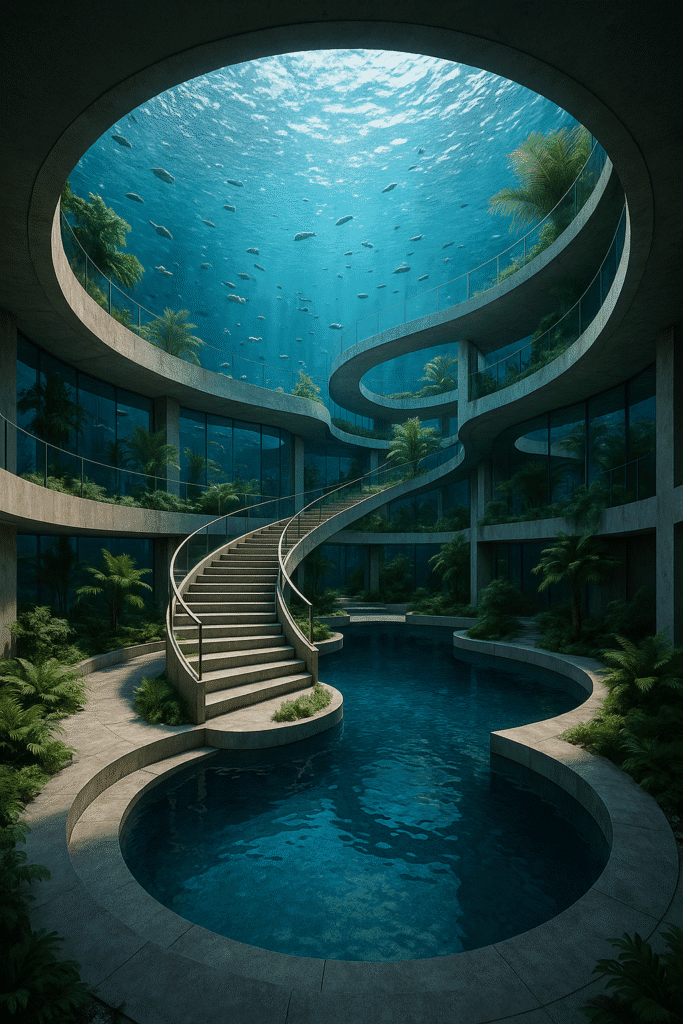10 Reasons Why Underwater Atrium Architecture Is the Future of Design
“Where ocean serenity meets architectural mastery”

Introduction: A New Wave in Architecture
Underwater atrium architecture is not science fiction anymore. This groundbreaking concept is reshaping how we think about space, sustainability, and the emotional connection between humans and nature. With global climate awareness rising and a hunger for innovative design, underwater atriums represent a bold leap toward future-ready living.
Whether it’s a tranquil home retreat, a luxury resort, or an ocean research hub, the fusion of water and space is no longer a fantasy—it’s feasible, and it’s stunning.
What Is Underwater Atrium Architecture?
Underwater atrium architecture refers to buildings or spaces that incorporate submerged glass-walled interiors, often placed below sea level, offering panoramic views of the marine world. These designs use high-strength transparent materials and sustainable engineering to create immersive environments where humans can live, relax, or work under water.
By incorporating an atrium—a central, open space—these structures balance openness with intimacy, giving users the sensation of being one with the ocean.
1. Biophilic Immersion Enhances Mental Health
Humans are wired to connect with nature. Underwater atriums offer continuous exposure to flowing water, organic movement, and marine biodiversity—all of which are known to reduce stress and promote mindfulness.
💡 Did you know? According to Harvard Health, nature immersion can improve cognitive function and reduce anxiety.
2. Natural Light Diffusion Improves Energy Efficiency
One of the core strengths of underwater atrium architecture is how it leverages sunlight. Using low-emissivity glass domes, natural light filters through water and into the space, eliminating harsh glare while reducing the need for artificial lighting during the day.
This passive lighting technique not only cuts energy bills but also creates a calming, diffused ambiance—something impossible to replicate on land.
3. Sustainable Engineering Makes It Realistic
Technologies such as:
- Marine-grade concrete
- Triple-layered acrylic
- Wave-pressure compensation systems
…make these structures structurally sound and long-lasting. Companies like ReefLine are already exploring aquatic infrastructure that benefits both humans and marine ecosystems.
4. A Living Gallery of Marine Life
Imagine sipping tea while watching stingrays glide overhead.
An underwater atrium turns everyday life into an ever-changing, interactive exhibit of ocean life. This interaction strengthens awareness and respect for marine ecosystems, especially in hospitality and research applications.
5. Architectural Flexibility
From cylindrical cores to spiral descending galleries, underwater atriums come in various layouts. They can be:
- Full rooms submerged beneath sea level
- Partial basements connected to above-ground spaces
- Floating pods with below-surface atriums
This flexibility makes them suitable for private villas, public installations, or even commercial centers.
6. A Unique Selling Point for Hospitality & Wellness
Boutique hotels and wellness centers can leverage underwater atrium architecture as a luxury differentiation point. The visual and emotional impact is immediate and unforgettable, offering guests a rare, Instagram-worthy experience grounded in serenity.
✨ Example: The Muraka at Conrad Maldives offers a real underwater suite—proof that the concept is already market-viable.
7. Thermoregulation Through Water Insulation
Surrounded by water, these buildings benefit from natural thermal stability. The sea regulates interior temperatures more consistently than air, decreasing HVAC usage while enhancing comfort.
8. Ideal for Climate-Resilient Design
As sea levels rise, architects must think vertically and subaqueously. Underwater atriums offer a viable, inspiring path toward flood-resilient buildings that embrace—not resist—the ocean.
9. Emotional Resonance Through Stillness
“To be underwater is to listen to silence with your eyes.”
The emotional impact of underwater atrium architecture is profound. The slow dance of light, the rhythm of the tide, and the sense of cocooned openness create a deeply introspective environment. It’s a space where architecture becomes a feeling.
10. A Future-Proof Investment
While the upfront cost is high, underwater architecture positions investors and developers as pioneers. It attracts attention, drives media buzz, and defines legacy projects that stand apart in a saturated market.
Explore Related Visions from Gplex
- Sunlit Calm – A Natural Living Room Interior by Gplex
- The Light Collector – Surreal Glass Dome Architecture
- Learn more about biophilic interior design
Final Thoughts
Underwater atrium architecture is not just a trend—it’s a movement. It combines sustainability, emotion, and innovation into a singular design language that speaks to the future of architecture. At Gplex, we celebrate this new frontier where the walls breathe water and the sky glows from beneath.
As oceanfront cities evolve, so must our imagination. And this is where it starts.
This space is yours, too.
Leave a Thought
What did this post make you feel?
We’d love to hear your reflections.